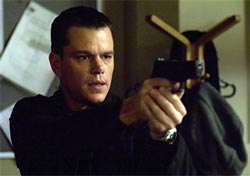Cut to the Chase: "The Bourne Ultimatum"
The Bourne Ultimatum (2007, Dir. Paul Greengrass)
"Will you commit to this program?"
Jason Bourne (Matt Damon), ex-government assassin and taciturn survivalist, is asked this very question in a grainy flashback early on in The Bourne Ultimatum, and it just as easily could be an appeal to the audience: would we kindly commit to a film series with a hero just as indestructible as James Bond, but loaded with amnesia and moral regret over the beast he has become? More precisely, is this cipher-like Mr. Bourne compelling enough for us to follow him to the ends of the world, as he seeks to break the final locks on his clouded memory and discover what it was that drove him to take on the job of ultra-ultra-secret hitman?
The answer seems to be an unequivocal yes, based on the critical plaudits lavished on the third entry of the Bourne saga. In the current real-world climate, we dig spy thrillers that can inject just a smidgen of realism into the usual outlandish antics, and it doesn't hurt if they don't insult our intelligence outright. Thus we have The Bourne Ultimatum, a nifty piece of filmmaking that is nearly peerless in its action-reaction thriller mechanics.
"Will you commit to this program?"
Jason Bourne (Matt Damon), ex-government assassin and taciturn survivalist, is asked this very question in a grainy flashback early on in The Bourne Ultimatum, and it just as easily could be an appeal to the audience: would we kindly commit to a film series with a hero just as indestructible as James Bond, but loaded with amnesia and moral regret over the beast he has become? More precisely, is this cipher-like Mr. Bourne compelling enough for us to follow him to the ends of the world, as he seeks to break the final locks on his clouded memory and discover what it was that drove him to take on the job of ultra-ultra-secret hitman?
The answer seems to be an unequivocal yes, based on the critical plaudits lavished on the third entry of the Bourne saga. In the current real-world climate, we dig spy thrillers that can inject just a smidgen of realism into the usual outlandish antics, and it doesn't hurt if they don't insult our intelligence outright. Thus we have The Bourne Ultimatum, a nifty piece of filmmaking that is nearly peerless in its action-reaction thriller mechanics.
Like a shark, the film survives on constant movement, one breathless chase and averted trap after another. Those who haven't seen the first two films, The Bourne Identity and The Bourne Supremacy (directed by Doug Liman (who also serves as the guiding hand behind the series) and Paul Greengrass, respectively) will have to make do with some handy flashbacks, but story is truly secondary here; just think of Bourne as the wily mouse, and the big bad CIA, his former employer, as the giant cat threatening to sink its claws into him, and you're ready to sit back and have your eyeballs seared by the frenetic, handheld style that is fast becoming Greengrass's calling card. Which is not to say that Ultimatum is undisciplined or a migraine nightmare -- within the constant whooshes and bobbing movements of the camera, Greengrass manages to build choreography, rhythm, and suspense, little details popping out to ground us even in the midst of giant crowds on a train platform, or amongst the mountainous rooftops of a Moroccan city.
Happiest when our hero is in direct peril, the film's two major action sequences are adrenaline dreams. The first is a manhunt inside London's Waterloo Station wherein Bourne must rendezvous with nosy British reporter Simon Ross (a wasted Paddy Considine) and avoid the myriad closed-circuit cameras and agents on their tail. Armed with only two cell phones and a preternatural ability to sense danger, Bourne simultaneously avoids and gets the drop on his foes, and as he does so the sequence becomes a master class in geography, movement, and tension -- there must have been an army of editors working around the clock on this one, and the results are worth it. The second bravura setpiece is a footchase amongst the alleys and rooftops of Tangier in which Bourne must catch up with a CIA bagman who is on his way to rub out Nicky (Julia Stiles), his last tangible link to his days as an amnesia-free assassin. Juxtaposing pure acrobatic thrills -- Bourne pulling off his best Parkour impersonation as he leaps through windows -- with the inexorable march of the hitman closing in on his prey, it culminates in a one-on-one fistfight in a bathroom that puts a similar moment in Casino Royale to shame (ironically enough, Gary Powell is the fight choreographer for both films).
As Bourne escapes to freedom (and the inevitable sequel), one must ask, where do we go from here? The Bourne series has come full circle: it began with a man minus his memory adrift in the ocean, and it concludes with a shot of a man minus a personality swimming away. As an example of buffed-up action cinema, The Bourne Ultimatum fits the bill, but there's a remarkable hollowness at its core -- after three movies, the chase is over, and what a marvelous chase it has been at times, and yet can one truly say that the story has even begun? Folding back in on itself, like a snake engorged on its own tail, the series is an exercise in high style, conducted in a vacuum.








0 Comments:
Post a Comment
<< Home